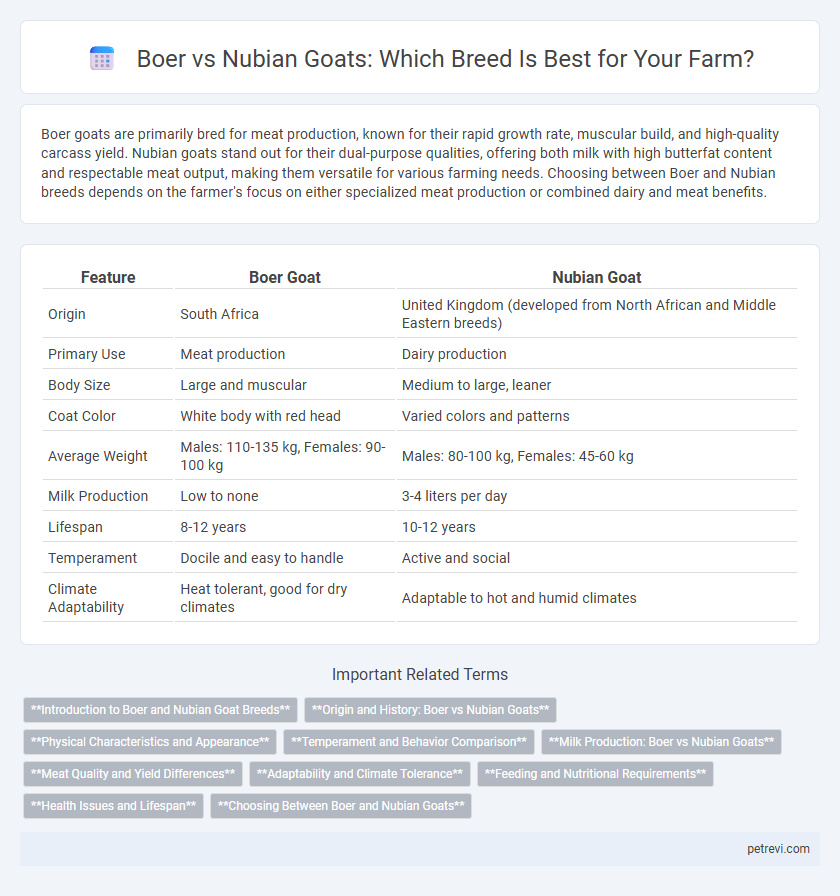Boer goats are primarily bred for meat production, known for their rapid growth rate, muscular build, and high-quality carcass yield. Nubian goats stand out for their dual-purpose qualities, offering both milk with high butterfat content and respectable meat output, making them versatile for various farming needs. Choosing between Boer and Nubian breeds depends on the farmer's focus on either specialized meat production or combined dairy and meat benefits.
Table of Comparison
| Feature | Boer Goat | Nubian Goat |
|---|---|---|
| Origin | South Africa | United Kingdom (developed from North African and Middle Eastern breeds) |
| Primary Use | Meat production | Dairy production |
| Body Size | Large and muscular | Medium to large, leaner |
| Coat Color | White body with red head | Varied colors and patterns |
| Average Weight | Males: 110-135 kg, Females: 90-100 kg | Males: 80-100 kg, Females: 45-60 kg |
| Milk Production | Low to none | 3-4 liters per day |
| Lifespan | 8-12 years | 10-12 years |
| Temperament | Docile and easy to handle | Active and social |
| Climate Adaptability | Heat tolerant, good for dry climates | Adaptable to hot and humid climates |
Introduction to Boer and Nubian Goat Breeds
Boer goats, originating from South Africa, are renowned for their rapid growth rate and substantial meat yield, making them a preferred choice for commercial meat production. Nubian goats, distinguished by their long, floppy ears and Roman noses, are primarily dairy breeds that produce high-butterfat milk ideal for cheese and yogurt. Both breeds offer unique traits: Boer goats excel in meat quality and hardiness, while Nubians provide superior milk production and adaptability to hot climates.
Origin and History: Boer vs Nubian Goats
Boer goats originate from South Africa and were developed in the early 1900s primarily for meat production, known for their rapid growth and robust build. Nubian goats, with roots tracing back to Africa, the Middle East, and India, boast a longstanding history as dual-purpose animals valued for both milk and meat. The distinct regional breeding purposes shaped the Boer's muscular conformation for meat and the Nubian's high milk yield and adaptability.
Physical Characteristics and Appearance
Boer goats exhibit a robust build with a broad chest, strong legs, and a distinctive white body paired with a red head, making them easily recognizable. Nubian goats are characterized by their long, pendulous ears and convex "Roman" nose, alongside a variety of coat colors and patterns. While Boers are generally bulkier and muscular, Nubians have a more refined, angular frame with a pronounced Roman nose and larger ears that enhance their distinctive appearance.
Temperament and Behavior Comparison
Boer goats exhibit a calm and docile temperament, making them easier to handle and ideal for novice breeders. Nubian goats are known for their outgoing, curious, and sometimes vocal behavior, which reflects their playful and social nature. Both breeds thrive in social herd environments, though Boers tend to be more placid while Nubians display higher energy and interaction levels.
Milk Production: Boer vs Nubian Goats
Nubian goats are renowned for their high milk production, often yielding 1 to 2 gallons per day with milk rich in butterfat content ranging from 4% to 5%, making it ideal for cheese and yogurt. Boer goats, primarily bred for meat, produce significantly less milk, typically between 0.5 to 1 gallon daily, with lower butterfat levels around 3% to 4%. Dairy farmers prioritize Nubian goats for milk production due to their superior volume and quality compared to Boer goats.
Meat Quality and Yield Differences
Boer goats exhibit superior meat quality and higher yield due to their muscular build and faster growth rate compared to Nubian goats, which have a leaner frame and produce less carcass weight. Boer meat tends to have a finer texture and more consistent marbling, enhancing flavor and tenderness. Nubians, while valued for milk production, generally yield lower meat quantity and a coarser grain, making Boers the preferred breed for meat-focused farming.
Adaptability and Climate Tolerance
Boer goats exhibit strong adaptability to arid and semi-arid climates, thriving in hot, dry environments due to their hardy constitution and resistance to heat stress. Nubian goats demonstrate exceptional tolerance to both hot and humid conditions, making them ideal for tropical and subtropical regions with high humidity levels. The resilience of Boer goats in drought-prone areas contrasts with the Nubians' flexibility across a wider range of warm climates, highlighting breed-specific advantages for targeted farming systems.
Feeding and Nutritional Requirements
Boer goats require a high-protein diet with adequate energy to support their rapid growth and muscle development, often benefiting from supplemental grains alongside high-quality forage. Nubian goats thrive on a balanced diet rich in fibrous roughage and require moderate protein levels to maintain their dairy production and overall health. Both breeds need constant access to clean water and mineral supplements to optimize digestion and nutrient absorption.
Health Issues and Lifespan
Boer goats are generally robust with strong resistance to parasites but may be prone to leg and hoof problems due to their heavier build, typically living around 8 to 12 years. Nubian goats have a longer lifespan, often reaching 10 to 15 years, but are more susceptible to respiratory issues and require diligent management to prevent infections. Both breeds benefit from regular health check-ups, parasite control, and proper nutrition to maximize their health and longevity.
Choosing Between Boer and Nubian Goats
Boer goats excel in rapid growth rates and high-quality meat production, making them ideal for commercial meat farming, while Nubian goats are prized for their abundant, rich milk with high butterfat content, suited for dairy purposes. Boer goats display a robust build and low maintenance needs, whereas Nubians have a more angular frame and require careful management to optimize milk yield. When choosing between Boer and Nubian goats, consider your primary goal--meat production favors Boer, and dairy production favors Nubian--to align breed characteristics with farming objectives.
Boer vs Nubian for Goat breed Infographic

 petrevi.com
petrevi.com